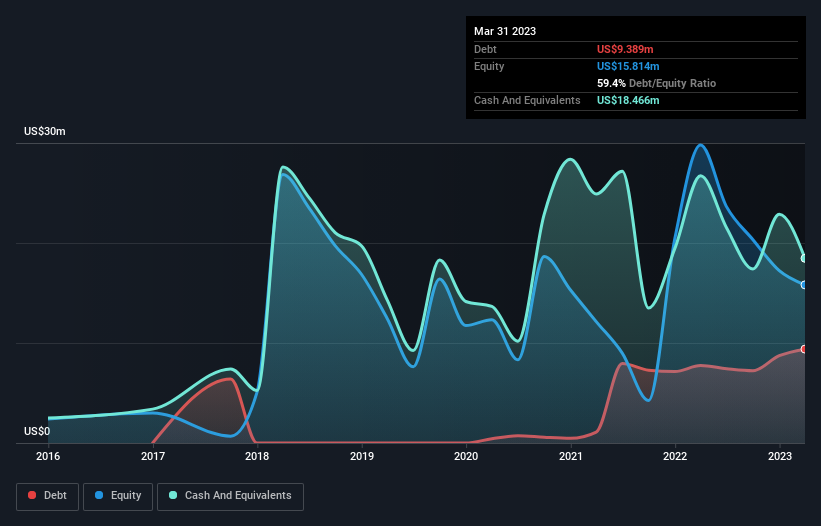
Warren Buffett famously said, 'Volatility is far from synonymous with risk.' So it might be obvious that you need to consider debt, when you think about how risky any given stock is, because too much debt can sink a company. We can see that Eyenovia, Inc. (NASDAQ:EYEN) does use debt in its business. But the real question is whether this debt is making the company risky.
What Risk Does Debt Bring?
Debt and other liabilities become risky for a business when it cannot easily fulfill those obligations, either with free cash flow or by raising capital at an attractive price. Part and parcel of capitalism is the process of 'creative destruction' where failed businesses are mercilessly liquidated by their bankers. However, a more usual (but still expensive) situation is where a company must dilute shareholders at a cheap share price simply to get debt under control. Of course, debt can be an important tool in businesses, particularly capital heavy businesses. The first step when considering a company's debt levels is to consider its cash and debt together.
View our latest analysis for Eyenovia
How Much Debt Does Eyenovia Carry?
The image below, which you can click on for greater detail, shows that at March 2023 Eyenovia had debt of US$9.39m, up from US$7.74m in one year. But on the other hand it also has US$18.5m in cash, leading to a US$9.08m net cash position.

How Strong Is Eyenovia's Balance Sheet?
We can see from the most recent balance sheet that Eyenovia had liabilities of US$4.90m falling due within a year, and liabilities of US$8.59m due beyond that. On the other hand, it had cash of US$18.5m and US$1.62m worth of receivables due within a year. So it actually has US$6.59m more liquid assets than total liabilities.
This short term liquidity is a sign that Eyenovia could probably pay off its debt with ease, as its balance sheet is far from stretched. Succinctly put, Eyenovia boasts net cash, so it's fair to say it does not have a heavy debt load! When analysing debt levels, the balance sheet is the obvious place to start. But it is future earnings, more than anything, that will determine Eyenovia's ability to maintain a healthy balance sheet going forward. So if you're focused on the future you can check out this free report showing analyst profit forecasts.
It seems likely shareholders hope that Eyenovia can significantly advance the business plan before too long, because it doesn't have any significant revenue at the moment.
So How Risky Is Eyenovia?
We have no doubt that loss making companies are, in general, riskier than profitable ones. And we do note that Eyenovia had an earnings before interest and tax (EBIT) loss, over the last year. And over the same period it saw negative free cash outflow of US$25m and booked a US$26m accounting loss. Given it only has net cash of US$9.08m, the company may need to raise more capital if it doesn't reach break-even soon. Overall, its balance sheet doesn't seem overly risky, at the moment, but we're always cautious until we see the positive free cash flow. When analysing debt levels, the balance sheet is the obvious place to start. However, not all investment risk resides within the balance sheet - far from it. For example, we've discovered 8 warning signs for Eyenovia (3 don't sit too well with us!) that you should be aware of before investing here.
When all is said and done, sometimes its easier to focus on companies that don't even need debt. Readers can access a list of growth stocks with zero net debt 100% free, right now.
Valuation is complex, but we're here to simplify it.
Discover if Hyperion DeFi might be undervalued or overvalued with our detailed analysis, featuring fair value estimates, potential risks, dividends, insider trades, and its financial condition.
Access Free AnalysisHave feedback on this article? Concerned about the content? Get in touch with us directly. Alternatively, email editorial-team (at) simplywallst.com.
This article by Simply Wall St is general in nature. We provide commentary based on historical data and analyst forecasts only using an unbiased methodology and our articles are not intended to be financial advice. It does not constitute a recommendation to buy or sell any stock, and does not take account of your objectives, or your financial situation. We aim to bring you long-term focused analysis driven by fundamental data. Note that our analysis may not factor in the latest price-sensitive company announcements or qualitative material. Simply Wall St has no position in any stocks mentioned.
About NasdaqCM:HYPD
Hyperion DeFi
An ophthalmic technology company, engages in development and commercialization of ophthalmic solutions in the United States.
Medium-low with imperfect balance sheet.
Market Insights
Community Narratives



